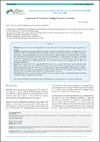Identificador persistente para citar o vincular este elemento:
https://accedacris.ulpgc.es/jspui/handle/10553/42027
| Título: | Comparison of two stair climbing protocols for smokers | Autores/as: | Gimenez, M. Saavedra-Santana, Pedro Lantarón, Eva M. Tran, J. Martín, N. Bach, J. R. |
Clasificación UNESCO: | 32 Ciencias médicas 1209 Estadística |
Palabras clave: | Maximal stair climbing test Pulmonary rehabilitation Aerobic exercise Cycle ergometry Endurance |
Fecha de publicación: | 2017 | Publicación seriada: | International Journal of Respiratory Disease, Care and Medicine (IJRDM) | Resumen: | Objectives: Compare two stair climbing protocols with each other and with an established cycle-ergometry protocol for smokers. Methods: In an exercise physiology laboratory, 25 smokers’ maximal O2 consumption (VO2max) was determined by cycleergometry at 30W/3 min increments. Then, randomly they performed either maximal fixed intensity (FiSC) or bi-level intensity (BiSC) stair-climbing protocols at the same pace to exhaustion, before crossing-over to perform the other 1 to 3 days later. The sequence was repeated 6 weeks later. The FiSC was performed on a 10 flight staircase. The BiSC was performed by repeatedly climbing and descending a single flight. Outcome measures were exertional dyspnea (ED), leg pain (LP), respiratory rate (RR), heart rate (HR), peripheral pulse oximetry (SpO2), blood pressure, physiologic cost index (PCI), and self-reported preferences. Results: All 25 subjects climbed the single-flight BiSC 10 times but no one could climb more than 8 consecutive flights (FiSC). Eighty to 95% of heart rate at VO2max was achieved by both, but the BiSC was significantly better tolerated over ten flights with significantly lower HR (<.001), PCI (<.001), ED and LP (p <0.05), and higher RR (<.001) and SpO2 (<.004). In addition, using only one flight was more practical, for both de subjects himself and for surveillance by the medical staff to control the speed of climbing, and the subjective and cardio respiratory responses. Conclusion: The protocol of Bi-level exercise repeatedly climbing one flight of stairs is more practical, effective, and better tolerated than that of continuous stairs climbing. | URI: | https://accedacris.ulpgc.es/handle/10553/42027 | ISSN: | 2577-4409 | DOI: | 10.19070/2577-4409-170003 | Fuente: | International Journal of Respiratory Disease, Care and Medicine (IJRDM) [ISSN 2577-4409], v. 2 (1), p. 8-13 |
| Colección: | Artículos |
Visitas
131
actualizado el 04-may-2024
Descargas
115
actualizado el 04-may-2024
Google ScholarTM
Verifica
Altmetric
Comparte
Exporta metadatos
Los elementos en ULPGC accedaCRIS están protegidos por derechos de autor con todos los derechos reservados, a menos que se indique lo contrario.
